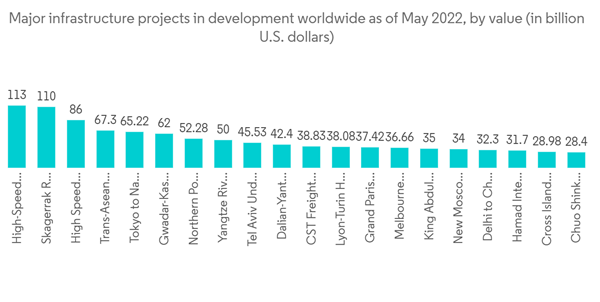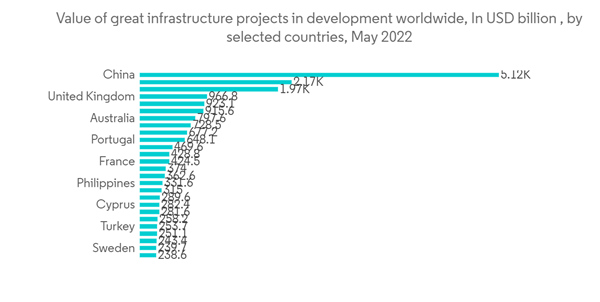The key factors propelling market expansion are the rising volume of traffic on the roads and the expanding number of automobiles. In addition, the need for railway bridges is increasing as a result of the growth of rail networks and the increasing emphasis on public-private partnerships for the development of transportation infrastructure.
The bridge construction market comprises sales made by organizations, sole proprietors, and partnerships. Bridge construction refers to building a structure across a physical barrier, such as water bodies, valleys, or highways, to provide a crossing over that barrier. Depending on how the bridge will structurally behave, common materials used in bridge building include structural steel, reinforced concrete, pre-stressed concrete, and post-tensioned concrete.
Beam, truss, arch, suspension, and cable-stayed bridges are among the common forms of bridge construction. The term "beam bridge" refers to a horizontal structure that rests on two ends supports and acts as a beam to carry traffic. Beam bridge construction is sold by entities (organizations, partnerships, and sole proprietors).
The beam is strong enough to support the static and dynamic stresses placed on it. In the construction of bridges, materials like steel, concrete, and composites are used. Roads, highways, and railroads are among the infrastructure types for which bridges are built.
This infrastructure supports the long-term viability of homes and companies by including structures like buildings, roads, electricity sources, and bridges. Hard infrastructure, which consists of the physical systems that serve to handle expanding traffic, includes bridges.
For instance, according to a study released by the Department for Promotion of Industry and Internal Trade (DPIIT) in February 2021, FDI investments in infrastructure development and construction were USD 17.22 billion in 2020. They were projected to reach USD 1.4 trillion by the end of 2023. As a result, future expansion in bridge construction will be supported by increased investments in infrastructure development.
The bridge construction market is changing due to the introduction of new technology. Major corporations in the bridge construction market are concentrating on integrating innovative technologies to build better, faster, and longer lifespan bridges. New technologies like road-rail cable-stayed are utilized when building new bridges, particularly those over rivers.
Bridge Construction Market Trends
The railway sector is anticipated to expand significantly over the anticipated period.
Type, material, application, and geography are used to categorize the bridge construction market. The international market is divided into several types, including beam, truss, arch, suspension, cable-stayed, and others. The market is divided into steel, concrete, and composite material segments. The bridge building market is divided into two segments based on application: road & highway and railway. The bridge-building market is examined by region, including LAMEA, North America, Europe, and Asia-Pacific. Due to rising urbanization and increased investments in infrastructure, the Asia-Pacific region is anticipated to hold a disproportionately large share of the worldwide bridge-building market throughout the study period.The High-Speed Rail Line in California (United States) was, as of October 2022, one of the most valuable infrastructure projects either in their planning or execution phase worldwide. Most of the major infrastructure projects in development were railway lines, such as the ones in Norway and Sweden, the UK, the US, Asia and South-East Asia, and Japan. The country with the highest number of great infrastructure projects valued at over USD 25 million was India.
For Instance, the first vertical lift Rail Sea Bridge in India is actively being constructed by Railways. The first vertical lift railway bridge in India, also known as the Pamban Bridge, which connects the Indian mainland with Rameswaram Island, just featured in photos posted by the Ministry of Indian Railways along with construction updates. According to the most recent data, 81% of the bridge's construction is finished. After construction is finished, the bridge will assist the trains in carrying additional weight due to the increasing volume and pace of traffic on the route. The ships and streamers can move through this bridge without encountering any obstructions.
The first vertical lift railway sea bridge in India, the Pamban Bridge, which connects the Indian mainland with Rameswaram Island, finished 81% of its construction work, according to the Ministry of Railways. All 333 piles are built, 101 pile caps and substructures are finished, and 76 of 99 girders are launched.
Asia-Pacific Region dominates the market
Significant infrastructure development is now more crucial than ever in the Asia Pacific. Urbanization, population increase, and economic development all contribute to the urgent demand for new and upgraded infrastructure. Long-term infrastructure planning is further complicated by the disparity in infrastructure development between territories. Although the availability and caliber of infrastructure, as well as the capacity and ability to plan and finance infrastructure projects, vary significantly between developed and developing economies, they all include one issue in common: tight budgets. Some governments can finance their infrastructure exclusively.If the region is to sustain economic growth, combat poverty, and reduce climate risk, the Asian Development Bank (ADB) estimated that roughly USD 1.7 trillion will need to be invested annually in infrastructure across Asia through 2030. It is more than twice the amount of investment that the ADB recommended in 2009. The difference between projected infrastructure requirements and delivered infrastructure is widening.
In China, the infrastructure projects in development or execution of over USD 25 million as of May 2022 were worth over USD 5 trillion. The United States and India were the following countries on the list, with around USD 2 trillion worth of infrastructure projects. In contrast, the country with the highest number of big infrastructure projects was India.
By 2026, renewable electricity capacity worldwide is forecasted to rise more than 60% from 2020 levels, equivalent to the current total global power capacity of fossil fuels and nuclear combined. About 40% of the world's population currently lives within 100 km of the coast, adding increased pressure to coastal ecosystems.
Bridge Construction Industry Overview
Robots, virtual reality, and augmented reality technologies are among the cutting-edge technologies being utilized to build bridges faster and with lower operational costs. For instance, to enhance the structural performance of the bridges, the new arch steel bridge that is currently being built in Bangladesh is using cutting-edge technologies in bridge maintenance and management. ACS Group, AECOM, Balfour Beatty, China Communications Construction Company Limited, and many more are some of the major players. To increase their market reach and compete in the markets, the major players adopted key strategies like product development, business expansion, agreements, partnerships, and acquisitions. These strategies are now being used to build bridges at lower operational costs and shorten project lead times.Additional Benefits:
- The market estimate (ME) sheet in Excel format
- 3 months of analyst support
This product will be delivered within 2 business days.










